The Best Way to Make Sure Your Packages Are Safe
- Written by Daily Bulletin

When shipping valuable or fragile items, ensuring that your packages arrive safely at their destination is crucial. Whether you're a business sending products or an individual mailing a gift, protecting the contents inside the box is key to avoiding damage and ensuring customer satisfaction. In this article, we will explore the best ways to secure your packages using proper packing materials and methods, including the use of voidfill and Polyfoam Rolls.
Why Package Safety Matters
Shipping can be rough on packages. Boxes are often handled multiple times, stacked, and jostled during transport. Without proper packing, your items may shift around inside the box, leading to scratches, dents, or even breakage. Investing in quality packing materials and using the right techniques can prevent damage and ensure that your package arrives intact.
Step 1: Choose the Right Box
The first step to package safety is selecting the correct box. It should be sturdy enough to withstand the shipping process and the appropriate size for your items. A box that’s too large will leave too much room for movement, while a box that’s too small could lead to crushing or insufficient protection.
Step 2: Fill Empty Spaces with Voidfill
To prevent items from shifting during transit, it’s essential to use voidfill. Voidfill refers to materials that fill the empty space within a box, keeping items secure. These materials can include packing peanuts, air pillows, or crumpled paper. By filling the gaps, voidfill ensures that your items remain in place, reducing the risk of impact damage from movement inside the box.
When using voidfill, make sure you’ve packed enough to firmly hold your items without overpacking, which could place unnecessary pressure on the contents.
Step 3: Use Protective Materials Like Polyfoam Rolls
For especially delicate items, using protective wrapping materials is a must. One of the best options for this purpose is Polyfoam Rolls. These rolls provide a lightweight, flexible layer of cushioning that protects fragile items from impacts, vibrations, and pressure.
Polyfoam Rolls are particularly useful for wrapping items like electronics, glassware, or furniture, as they create a soft buffer around the object without adding significant weight to the package. They can be wrapped around individual items or layered between items within the box to provide extra protection.
Step 4: Reinforce Your Package
Once your items are securely packed with voidfill and wrapped in protective materials, it’s time to reinforce your package. Use high-quality packing tape to seal the box, ensuring that all seams are tightly closed. For larger or heavier packages, consider double-taping the bottom and top flaps for added strength.
You can also reinforce the corners of your box with extra tape or corner protectors, especially if the package will be stacked with others during transport.
Step 5: Label Fragile Packages Clearly
If you’re shipping items that are particularly delicate, such as glass or electronics, it’s important to clearly label your package as "Fragile." This will help shipping personnel handle your package with care and avoid rough handling.
Additionally, consider purchasing insurance for high-value items in case something goes wrong during transit. This extra layer of protection will give you peace of mind and cover any potential damage or loss.
Conclusion: Protecting Your Packages the Right Way
Ensuring the safety of your packages during shipping comes down to using the right materials and packing methods. By filling empty spaces with voidfill, wrapping delicate items with Polyfoam Rolls, and reinforcing your boxes, you can significantly reduce the risk of damage during transit. With these steps in place, you can rest easy knowing your items will arrive safely at their destination, intact and undamaged.









